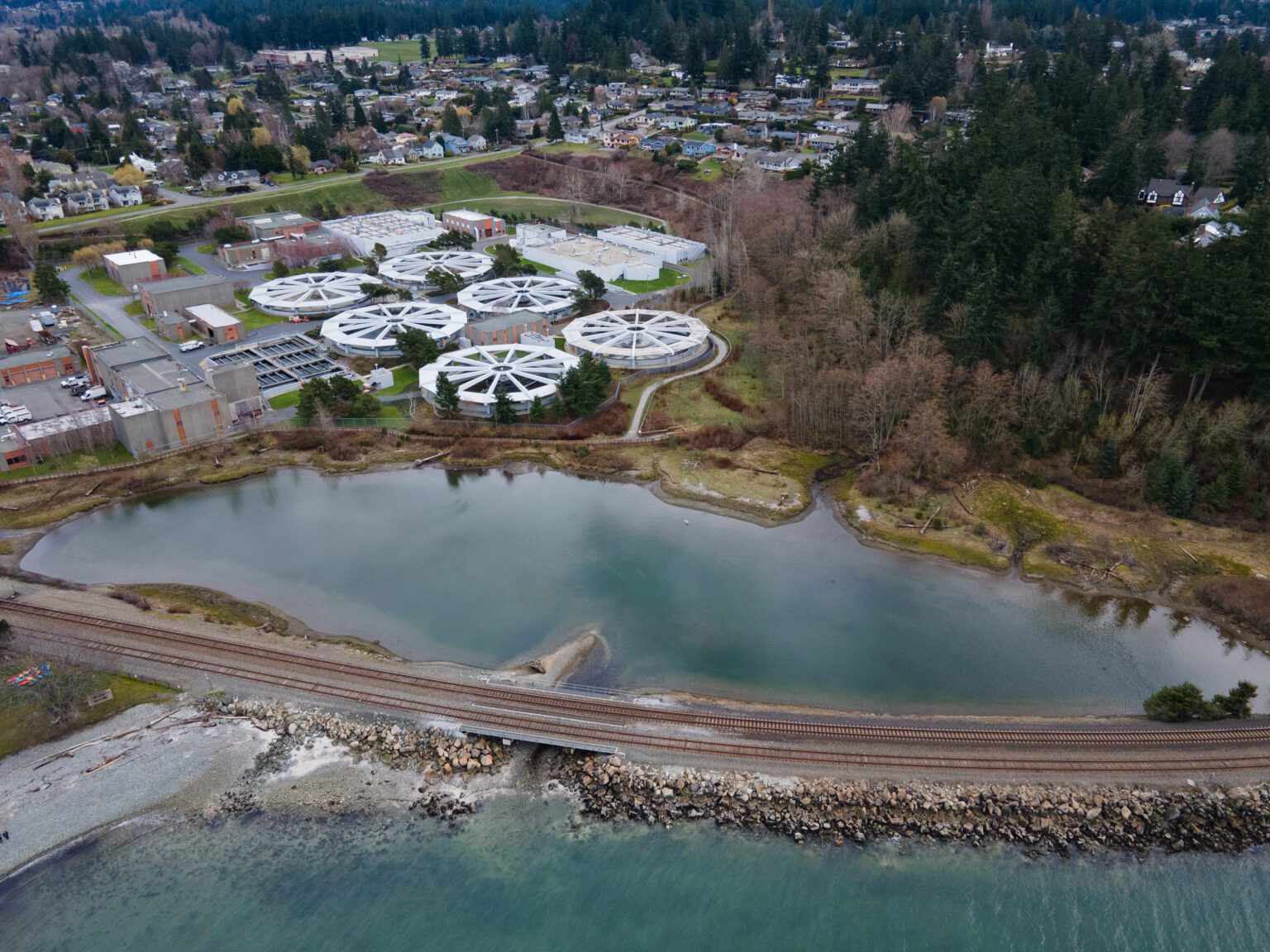The City of Bellingham is focusing on much-needed upgrades to the Post Point Wastewater Treatment Plant as officials seek a more environmentally friendly solution after a $1 billion plan to completely overhaul the solid waste system was rejected.
The repairs — expected to cost $100 million, based on a 2022 estimate — could extend the existing solids system’s life by 20 years, giving the city time to research and test greener, innovative technologies designed for future waste systems. The average waste treatment plant lasts 40 to 50 years. Post Point Wastewater Plant was installed in 1974.
Switching to a policy of preventative maintenance going forward could maintain the facility “in perpetuity,” said Public Works Director Eric Johnston.
Because the city previously anticipated replacing the system, it deferred many needed repairs, Johnston said. Now, the city is working on a long list of upgrades ranging from roof replacements, to control system upgrades, to cleaning up the land that the Unity Village Tiny Home is currently on.
In 2022, Bellingham City Council pivoted away from a years-in-the-making project to replace the incinerators with digesters. City council voted unanimously to suspend the project in September that year, reversing a 2017 decision to pursue a complete overhaul of the solids system.
It’s a long timeline — Johnston said it would be 10 to 20 years before a new system beyond incinerators is implemented. And even pilot projects are a couple of years out. And at some point in the next eight to 15 years, the city will have to build additional facilities to reduce “nutrient loading,” another top concern for officials to maintain the health of Puget Sound, Johnston said.
Funding for the maintenance projects will come from revenue from monthly wastewater rates paid by residents and customers, Johnston said. The city expects to be able to complete the projects without raising rates, but if a project at Post Point “triggers the need for additional funding from the [Lake Whatcom Water and Sewage District], the city will provide ample notification and work with the district towards meeting the needs of both parties,” he said in an email.
But interest remains in developing a more environmentally friendly, long-term option for solids handling at Post Point. Currently, plant operators remove the water from the waste stream and burn 4,650 tons of solids annually in the 50-year-old incinerators.
Incinerators can reduce the presence of PFAS, or per- and polyfluoroalkyl substances, Johnston said. But there are other issues, including the natural gas used to power incinerators.
PFAS, also known as “forever chemicals,” are in many common household items, including waterproof clothing, nonstick cookware and some fast food containers. They’re harmful to human health.
Four proposals were submitted to the city last November, but those remain only in the discussion phase.
Notice of violation
In the meantime, the city is also working with an outside law firm to resolve a notice of violation at the facility from the Northwest Clean Air Agency.
Bellingham Mayor Kim Lund said at an April city council meeting that the city takes the notice very seriously and that she is “eager to lead the hard work of investing in solutions that set Bellingham up for long-term success.”
Seth Preston, communications program manager at the Northwest Clean Air Agency, said a notice of violation is a “signal” to an air emissions source that the facility is not meeting the conditions of the permit or applicable regulations. Preston said the City of Bellingham is working on addressing these “diligently.”
“We’re expecting a good outcome,” he said.
Johnston said public works is eager to meet these requirements. City staff are currently undertaking an emissions control upgrades study to find a way to “ensure” the incineration process complies with regulations, he said. The city is also reviewing air quality regulations and permitting requirements for recent incinerator maintenance work and reducing carbon monoxide emissions.
The city has paid penalties for violations related to testing protocols and procedures, Johnston said — “which was one of the reasons why we were anxious to move away from the incineration to go to a process that would not have that same potential impact in terms of discharging byproducts of burning sludge.”
Northwest Clean Air Agency has issued the city four notices of violation for Post Point in the last decade, according to public records. Only once did the city have to pay a penalty — in the amount of $41,333 in 2019 for violations that occurred in 2016.
Two technologies have ‘potential’
Staff continue to investigate what the future could be beyond incinerators — in December, four companies pitched plans to the city for consideration. Those have now been narrowed down to two that pledge to destroy some PFAS.
The city is in discussions with the firm 374Water for a test in 2026-27. The company’s proposal would dissolve sludge into its most basic components using water in a “supercritical state.” A pilot project would cost the city $570,500.
The second option is Bioforcetech’s proposal to use a process called pyrolysis, which heats sewage sludge in the absence of oxygen, but no pilot project is planned for the immediate future. It comes at a high cost — $8.9 million — but eliminates PFAS. Staff are also looking outside of these two technologies.
Johnston said the two proposals have the “most potential” to align with what the community wants for the future of the plant.
The biggest question mark about these new technologies is that neither is currently working at scale in the world, without hitting roadblocks, Johnston said.
“We know of one in Australia that we thought was a success story, but we’re hearing more and more that it’s not and they’re having a lot of challenges,” said Michael Olinger, the city’s assistant public works director for operations.
Maile Lono-Batura, the director of sustainable biosolids program at the Water Environment Federation, said the conversation on finding cleaner technologies that eliminate potential contaminants like PFAS is a national and international challenge.
“Everybody is kind of in a similar space, just seeing who is doing what and who can actually be proof of concept to issue the capital investment that it would take to install these technologies,” she said.
City still must address nutrients
Beyond the maintenance and the pilot projects, nutrients remain top of mind for city staff working on the project.
The Department of Ecology is moving toward setting limits on the amount of nutrients wastewater treatment plants can discharge into Puget Sound. Excess levels of nutrients from humans, including nitrogen and carbon, can lead to low dissolved oxygen in Puget Sound, impacting the health of aquatic life.
Public works is studying what nutrients are being released by the plant, how that might be addressed in the current facility, and eventually, what limit Ecology is planning to set.
Johnston said that at some point in the next eight to 15 years, the city will have to build additional facilities to reduce “nutrient loading.”
That’s estimated to cost $400-500 million, in 2022 dollars. So, while the $1 billion overall project price is no longer on the table, major investments still must be made to keep the plant operational.
“It is going to be very expensive to deal with our wastewater and have the environmental responsibility we want to have,” Johnston said at an April council meeting.
Charlotte Alden is CDN’s general assignment/enterprise reporter; reach her at charlottealden@cascadiadaily.com; 360-922-3090 ext. 123.




